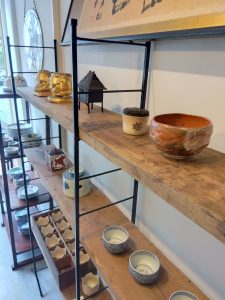初代帝室技芸員 田崎早雲 (愛知県名古屋市千種区姫池通 骨董買取 古美術風光舎)
2024.07.12

本日は、初代帝室技芸員にも選ばれた 日本画家 田崎早雲 のご紹介です。
日本画家 田崎草雲は1815年に生まれた日本を代表する画家の一人です。
田崎草雲は、文化12(1815)年10月15日に、江戸の神田小川町の足利藩邸内にて生まれ、幼い頃から親戚の金井烏洲(かないうじゅう)に絵画の手ほどきを受け、20歳のときに藩士をやめて谷文晁(たにぶんちょう)・渡辺崋山(わたなべかざん)という日本画の大家と呼ばれる二人に師事し本格的に絵画を学び始めます。嘉永6(1853)年には、足利藩の絵師になっています。
画家としても、評価の高い田崎草雲ですが、実は志士としても活躍をしています。志士たちと交友を深め、尊王の志を強くし、幕末・維新の動乱期には誠心隊(せいしんたい)という民兵組織を結成し治安維持にあたり、足利を戦火から守ったという記録が残されています。
そんな田崎草雲ですが、写実性の高い作品を多く残していることで知られます。南画の師である谷文晁や渡辺崋山亡き後、書画会における草雲の評価は低かったとされています。草雲は文晁を畏敬はしたが、真似をした作品を書くことを嫌がっていたといいます。プロ意識が高く、写実のため本草学も学ぶという熱心さがあり、凧の絵や浮世絵を書いたりして世渡りをする一方で、自らの描く芸術だけには信念を曲げることなく、江戸っ子としての「意地」の部分が草雲を大成させたと言えるのではないでしょうか。
そんな田崎草雲の作品は、山水画を始め、花鳥図、人物などが多いことが特徴です。「白華朱楼図」では、山水の方式を取り険しい岩肌の崖から覗く情緒ある寺院に橋など、基本に忠実に描かれています。その独特の強さや繊細な画風などは独特の雰囲気や空気感を得ることができる作品となっています。
初期の頃はあまり高い評価を得ていなかったと言われる田崎草雲ですが、次第に高い評価を得ていきます。明治23(1890)年には、芸術家にとって最も名誉ある帝室技芸員(ていしつぎげいいん)に、橋本雅邦(はしもとがほう)らとともに選ばれました。
また、後世の教育にも力を入れており、岱寺山(れんだいじやま)〔現:足利公園内〕に白石山房(はくせきさんぼう)を建て、足利では多くの弟子をとり絵画を教えました。しかし、絵を欲しがるだけの志しが低いものは受け入れることはせず、自身の目に敵う者だけに師事させたといいます。
また、司馬遼太郎の小説、「喧嘩早雲」のモデルともなっており、早熟の作家というよりは年をとるにつれ認められた作家といえるでしょう。弟子に小室翠雲がおり、時代の代表者として後輩画家を育てた経歴の持ち主です。
代表作は「蓬菜山図」「富嶽図」です。彼の各作品は国内だけでなく国外でも高い評価を受けています。「絹本着色 蓬莱仙宮図」に描かれた海と蓬莱山。「絹本墨画 富嶽図」の望遠鏡さえ使ったといわれる富士山の見事な風格。「絹本着色 花鳥図 3幅対」からは、喧嘩っ早い彼が小さなものをも愛していた様子が伺われます。
また、足利市には「早雲美術館」があり、足利が生んだ幕末の勤皇画家田崎草雲の遺作・遺品を展示しています。足利公園の南端にあり、美術館の横には草雲が画室や居宅として使っていた白石山房があります。
Today, we would like to introduce Soun Tasaki, a Japanese-style painter who was also the first Imperial Household Artist.
Japanese painter Soun Tasaki, born in 1815, is one of Japan’s leading painters.
He was born on October 15, 1815, in the Ashikaga domain residence in Kanda Ogawa-cho, Edo (present-day Tokyo). He began to study painting in earnest under Tani Buncho and Watanabe Kazan, two of the great masters of Japanese painting. In 1853, he became a painter for the Ashikaga clan.
Although highly regarded as a painter, Soun Tasaki was also active as a samurai. He formed a militia called “Seishintai” to maintain public order during the upheavals of the late Edo period and the Meiji Restoration, and protected Ashikaga from the fires of war.
Tazaki Soun is known for his highly realistic works. After the death of Tani Buncho and Watanabe Kazan, his teachers in nanga, Soun’s reputation in the calligraphy and painting circles was low. It is said that although Soun was in awe of Buncho, he did not want to write works that imitated him. He was highly professional and eager to learn herbology for the sake of realism, and while he was a world-famous artist who wrote kite paintings and ukiyoe, he never wavered in his belief in his own art, and it can be said that his “willfulness” as an Edo native made him a great artist.
The works of Soun Tasaki are characterized by their landscape paintings, flower-and-bird paintings, and human figures. In “Baihua Shurozu,” the artist has faithfully depicted the basics, such as a bridge and an emotional temple peeking out from a steep rocky cliff, following the landscape style. The unique strength and delicacy of the painting’s style give the work a distinctive atmosphere and atmosphere.
It is said that Soun Tasaki did not receive high acclaim in his early years, but he gradually gained a high reputation. In 1890, he was selected as a member of the Imperial Household Artists’ Association, the most prestigious honor for an artist, along with Hashimoto Gaho and others.
He also devoted himself to the education of future generations, building the Shiraishi Sambo (White Stone Mountain Studio) on Mount Rendaiji (now Ashikaga Park) and teaching painting to many students in Ashikaga. However, he did not accept those with low aspirations who only wanted to paint, and only allowed those who were good in his eyes to study under him.
He was also the model for Ryotaro Shiba’s novel, “Kenka Soun,” and can be considered a writer who was recognized as he grew older rather than a precocious artist. His pupil was Suiun Komuro, who was a representative of his time and trained junior painters.
His representative works are “Bokkaisan-zu” and “Fugaku-zu. Each of his works has been highly acclaimed not only in Japan but also abroad. The sea and Mount Horai depicted in “Horai Sengu Zu” (Coloring on Silk). The depth of the painting. Fuji, which is said to have even used a telescope in “Fugakuzu (Mt. Fugaku)” (ink painting on silk). The “Coloring on Silk, Flowers and Birds, Pair of Three Pairs” shows how he loved small things as well as quarrelsome ones.
Ashikaga City is also home to the Soun Tasaki Museum of Art, which exhibits the works and belongings of Soun Tasaki, an Ashikaga-born painter of the late Edo period. Located at the southern end of Ashikaga Park, next to the museum is the Shiraishi Yamabo, which Soun used as his painting studio and residence.
*******************
ご実家の整理やお片付けなどをされている方のご相談などが多くございます。
お片付けなどくれぐれもご無理のないようになさってくださいませ。
風光舎では古美術品や骨董品の他にも絵画や宝石、趣味のお品など様々なジャンルのものを買受しております。
お片付けをされていて、こういうものでもいいのかしらと迷われているものでも、どうぞお気軽にご相談下さいませ。
また風光舎は、出張買取も強化しております。ご近所はもちろん、愛知県内、岐阜県、三重県その他の県へも出張いたします。
まずは、お電話お待ちしております。
愛知県名古屋市千種区姫池通
骨董 買取【古美術 風光舎 名古屋店】
TEL052(734)8444
10:00-18:00 OPEN

